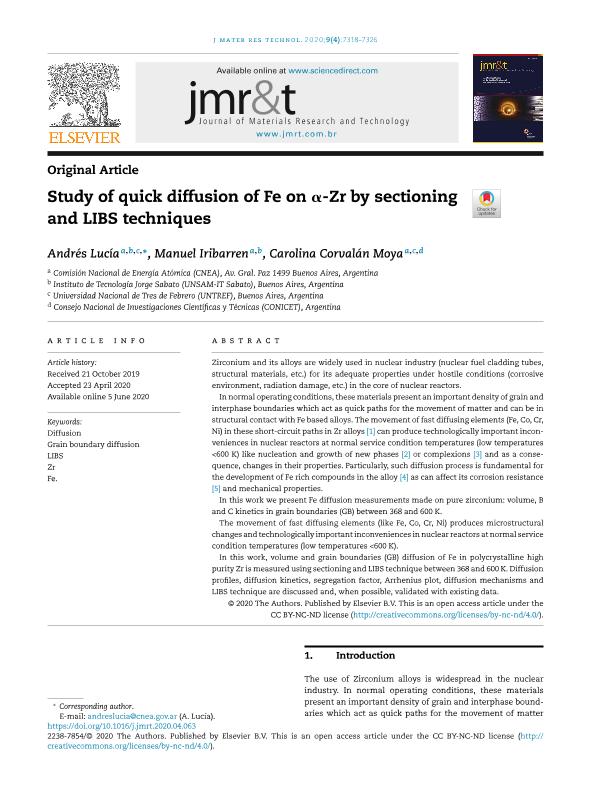Mostrar el registro sencillo del ítem
dc.contributor.author
Lucía, Andrés
dc.contributor.author
Iribarren, Manuel José

dc.contributor.author
Corvalán Moya, Carolina del Huerto

dc.date.available
2022-09-27T17:43:17Z
dc.date.issued
2020-07
dc.identifier.citation
Lucía, Andrés; Iribarren, Manuel José; Corvalán Moya, Carolina del Huerto; Study of quick diffusion of Fe on α-Zr by sectioning and LIBS techniques; Elsevier; Journal of Materials Research and Technology; 9; 4; 7-2020; 7318-7326
dc.identifier.issn
2238-7854
dc.identifier.uri
http://hdl.handle.net/11336/170661
dc.description.abstract
Zirconium and its alloys are widely used in nuclear industry (nuclear fuel cladding tubes, structural materials, etc.) for its adequate properties under hostile conditions (corrosive environment, radiation damage, etc.) in the core of nuclear reactors. In normal operating conditions, these materials present an important density of grain and interphase boundaries which act as quick paths for the movement of matter and can be in structural contact with Fe based alloys. The movement of fast diffusing elements (Fe, Co, Cr, Ni) in these short-circuit paths in Zr alloys [1] can produce technologically important inconveniences in nuclear reactors at normal service condition temperatures (low temperatures <600 K) like nucleation and growth of new phases [2] or complexions [3] and as a consequence, changes in their properties. Particularly, such diffusion process is fundamental for the development of Fe rich compounds in the alloy [4] as can affect its corrosion resistance [5] and mechanical properties. In this work we present Fe diffusion measurements made on pure zirconium: volume, B and C kinetics in grain boundaries (GB) between 368 and 600 K. The movement of fast diffusing elements (like Fe, Co, Cr, Ni) produces microstructural changes and technologically important inconveniences in nuclear reactors at normal service condition temperatures (low temperatures <600 K). In this work, volume and grain boundaries (GB) diffusion of Fe in polycrystalline high purity Zr is measured using sectioning and LIBS technique between 368 and 600 K. Diffusion profiles, diffusion kinetics, segregation factor, Arrhenius plot, diffusion mechanisms and LIBS technique are discussed and, when possible, validated with existing data.
dc.format
application/pdf
dc.language.iso
eng
dc.publisher
Elsevier

dc.rights
info:eu-repo/semantics/openAccess
dc.rights.uri
https://creativecommons.org/licenses/by-nc-nd/2.5/ar/
dc.subject
DIFFUSION
dc.subject
FE.
dc.subject
GRAIN BOUNDARY DIFFUSION
dc.subject
LIBS
dc.subject
ZR
dc.subject.classification
Ingeniería de los Materiales

dc.subject.classification
Ingeniería de los Materiales

dc.subject.classification
INGENIERÍAS Y TECNOLOGÍAS

dc.title
Study of quick diffusion of Fe on α-Zr by sectioning and LIBS techniques
dc.type
info:eu-repo/semantics/article
dc.type
info:ar-repo/semantics/artículo
dc.type
info:eu-repo/semantics/publishedVersion
dc.date.updated
2022-09-22T15:04:24Z
dc.journal.volume
9
dc.journal.number
4
dc.journal.pagination
7318-7326
dc.journal.pais
Brasil

dc.description.fil
Fil: Lucía, Andrés. Universidad Nacional de Tres de Febrero; Argentina. Comisión Nacional de Energía Atómica; Argentina. Universidad Nacional de San Martín. Instituto Sabato; Argentina
dc.description.fil
Fil: Iribarren, Manuel José. Comisión Nacional de Energía Atómica; Argentina. Universidad Nacional de San Martín. Instituto Sabato; Argentina
dc.description.fil
Fil: Corvalán Moya, Carolina del Huerto. Consejo Nacional de Investigaciones Científicas y Técnicas; Argentina. Universidad Nacional de Tres de Febrero; Argentina. Comisión Nacional de Energía Atómica; Argentina
dc.journal.title
Journal of Materials Research and Technology
dc.relation.alternativeid
info:eu-repo/semantics/altIdentifier/url/https://linkinghub.elsevier.com/retrieve/pii/S223878542031228X
dc.relation.alternativeid
info:eu-repo/semantics/altIdentifier/doi/http://dx.doi.org/10.1016/j.jmrt.2020.04.063
Archivos asociados
